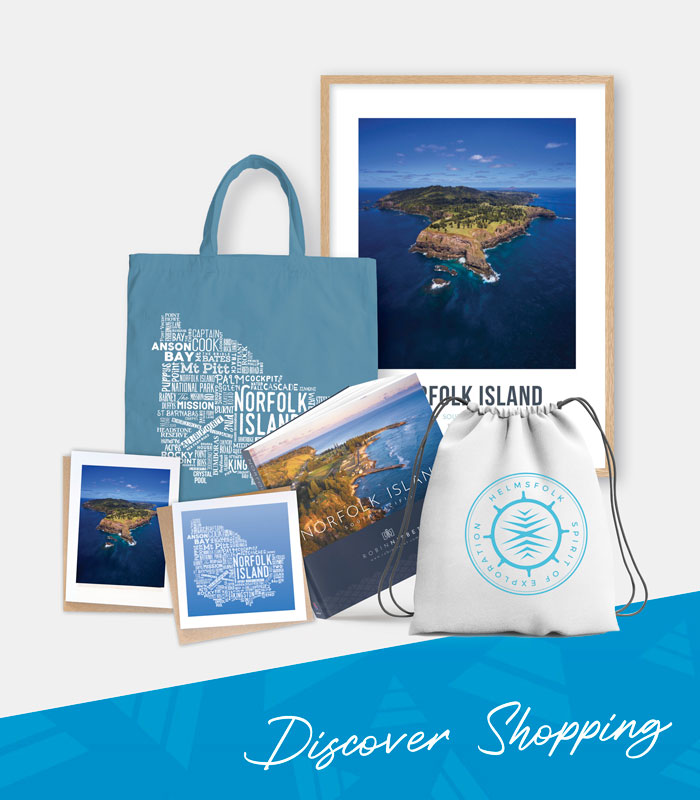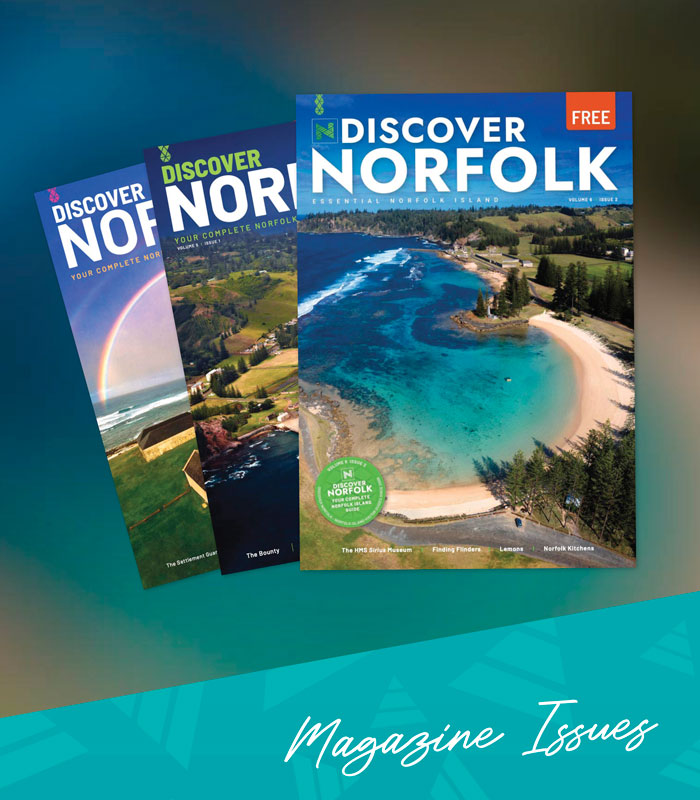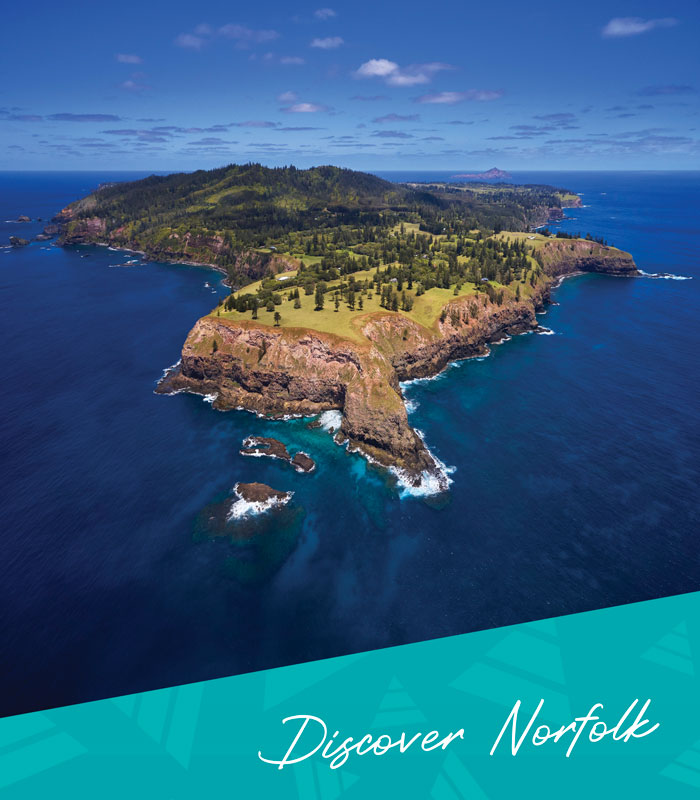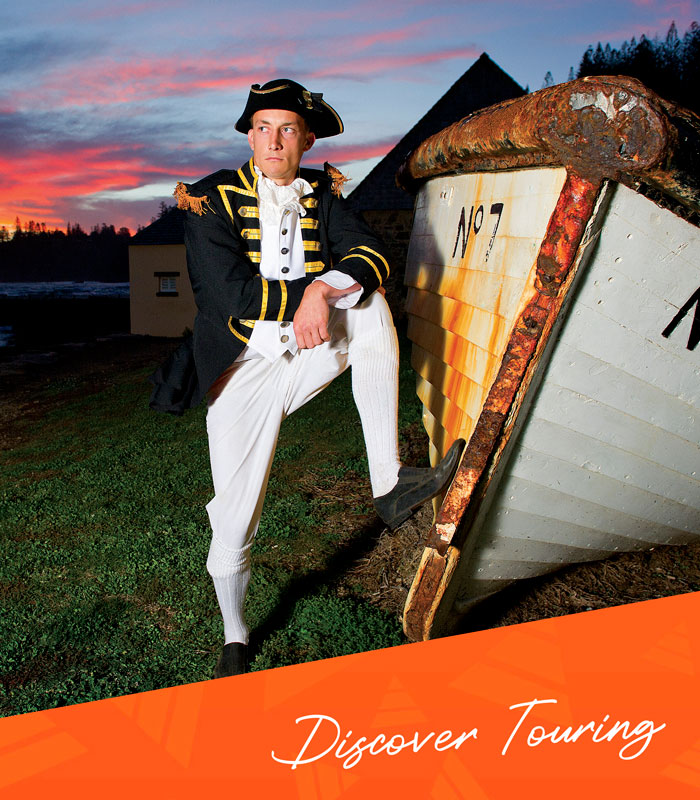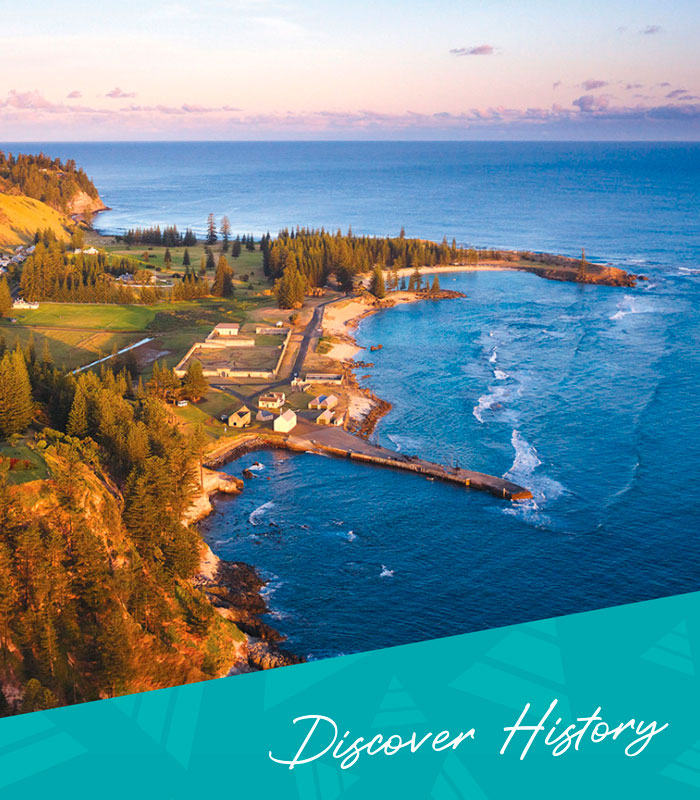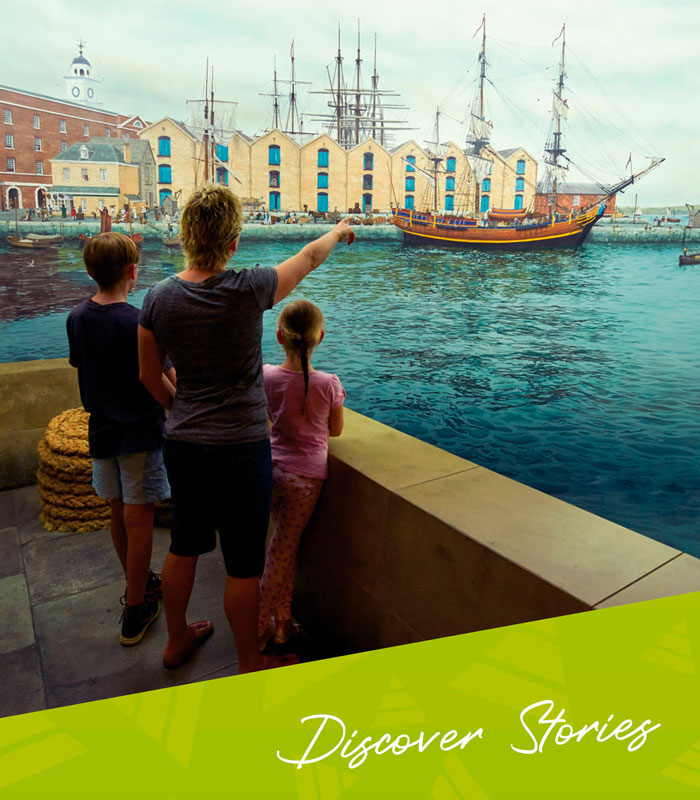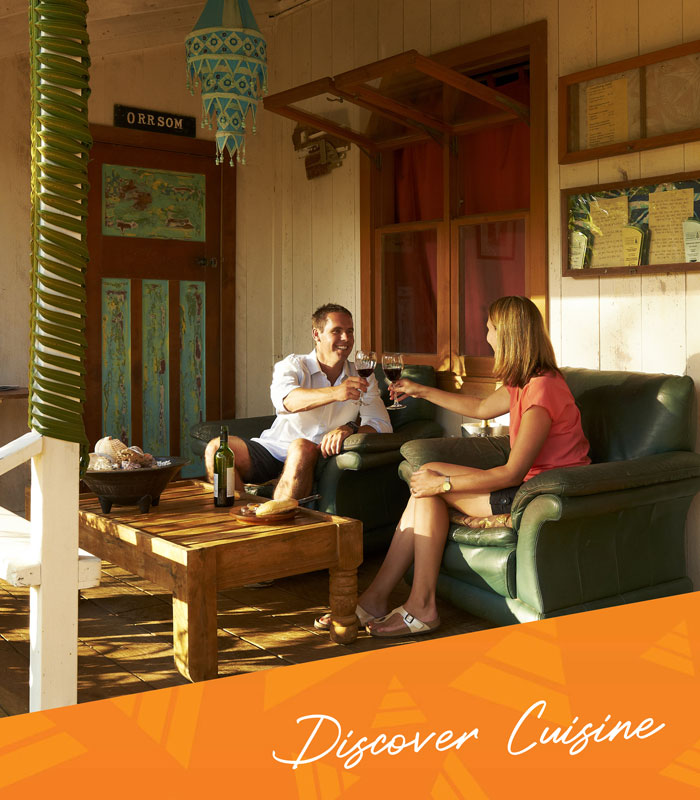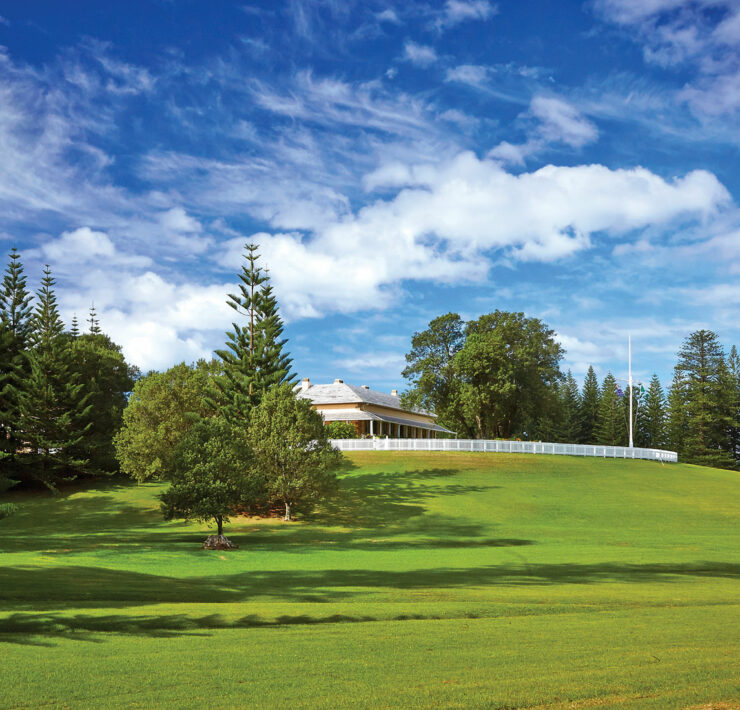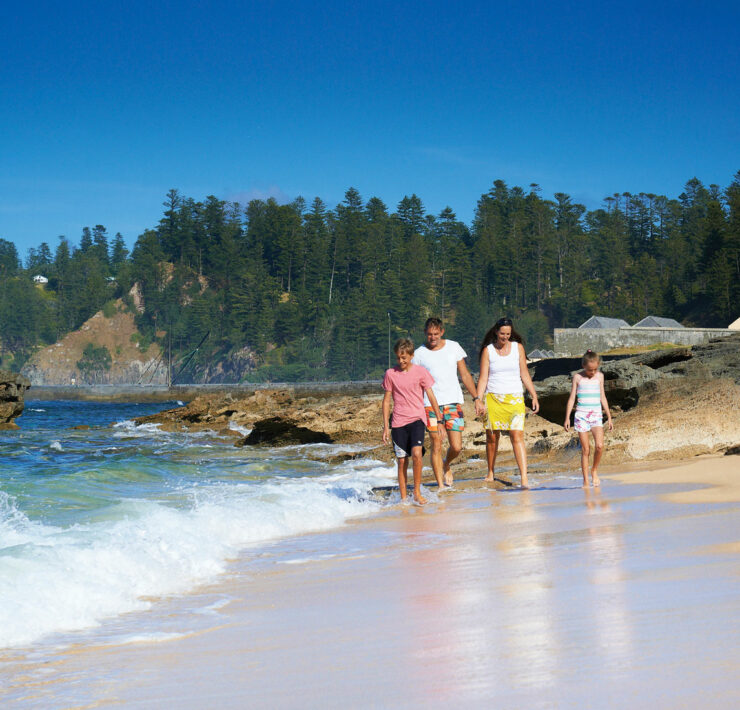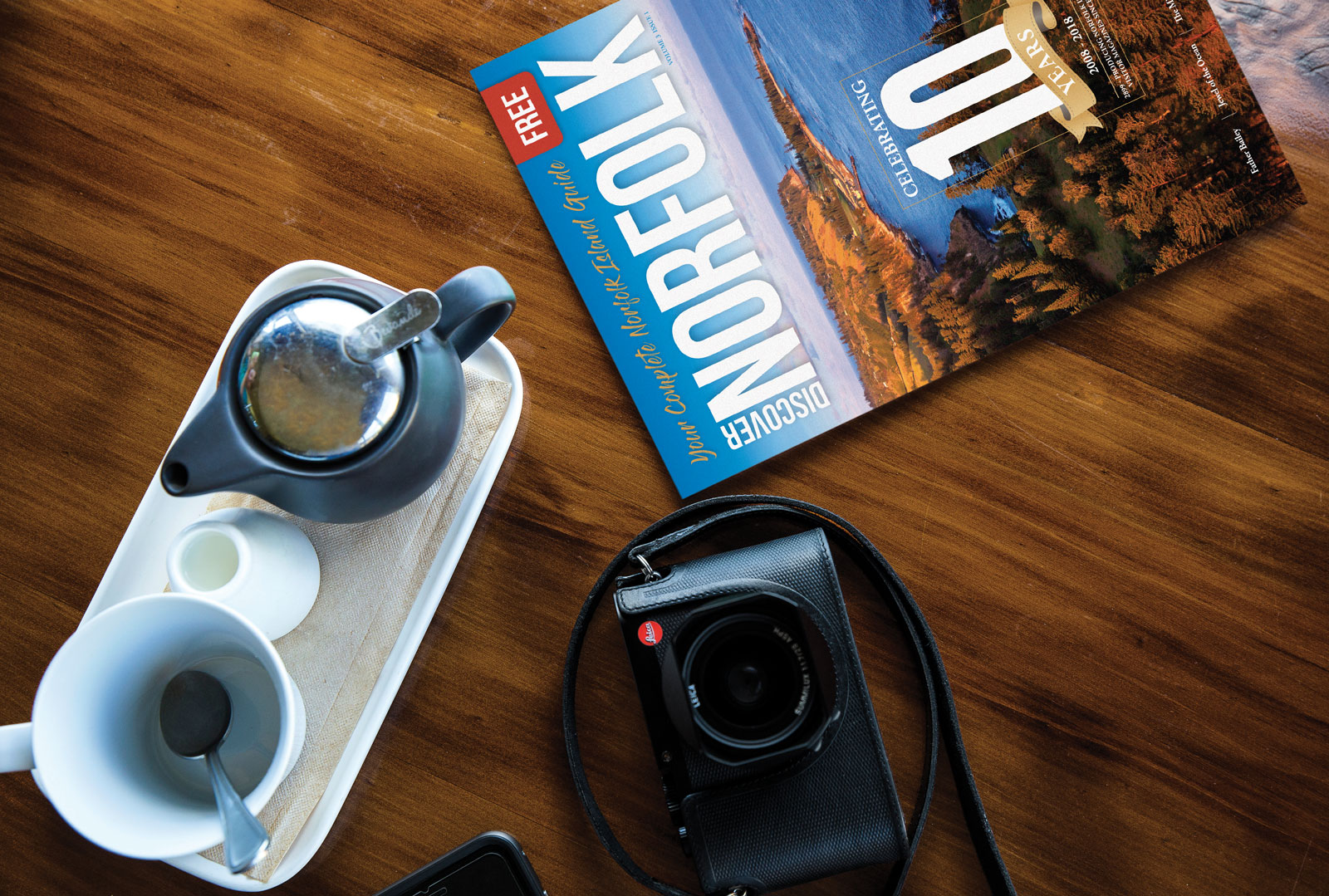Home » All Articles » The Longest Paddock: Cattle on Norfolk Island
The Longest Paddock: Cattle on Norfolk Island

One of Norfolk Island’s many surprises for visitors, especially those from the cities, is the sight of cattle wandering freely on roads, reserves and even through the World Heritage-listed Kingston and Arthur’s Vale Historic Area.
These friendly four-legged grass-mowers have been an integral part of Norfolk Island’s culture for many years. Cattle were first brought to Norfolk in 1794, six years after the First British Settlement was established. In the Second British Settlement, cattle were owned by the Government and strictly limited to discourage convicts from absconding and getting an easy meal. Many convicts came to the Island on a colonial conviction of ‘cattle theft’ – a life sentence that could be commuted to 10-15 years. Notable cattle-rustlers include William Jenkins, who worked as a servant at 10 Military Row (now known as Quality Row) and poor James Beams, who was in fact born on the Island during the First British Settlement and returned as a convict during the Second British Settlement.
When the Pitcairn Islanders arrived in 1856, the remaining sheep and cattle were handed over to them, with instruction that while families were able to take a milking cow, the rest were to remain on the common land. Whilst there had been small numbers of cattle on Pitcairn Island, the new residents of the Island very swiftly learnt how to use a bullock and plough, and the rest as they say, is history.
The most common breeds on the Island today are the Herefords and various Hereford crosses, but roaming around are also Aberdeen-Angus, Illawarra Short Horns, Simmental, Murray Greys, Friesian crosses, Speckle Parks, and of course the iconic ‘Norfolk Blue’ and the less well known, but just as prevalent ‘Norfolk Mongrels’ of dubious genetics. Today’s free-roaming cattle are placid and even quite friendly, a far cry from the early days of ‘fraidy moo-moos’.
Driving around the Island, tourists will notice cattle grazing along the road-side – this open-grazing on the commons is an ancient tradition and one that is alive and well here on Norfolk Island, keeping stock well fed and also providing an essential ‘mowing service’. Free-grazing, or ‘de-pastured’ cattle are one of the Island’s many charms, however they can pose a danger to motorists, especially at night. Cattle are fitted with reflective ear tags that make them easier to spot at night which is important as there an almost total absence of street lights.
Today, cattle are restricted in the areas they can roam, and their numbers are strictly controlled, though not too many decades ago it wouldn’t have been uncommon for cows to be window-shopping in Burnt Pine, grazing amongst the ruins in Kingston, or creating additional hazards for golfers on the course! Residents over the age of 18 can currently have up to 6 head of cattle on the roads, for the mere cost of $145 per animal to have it de-pastured.
Cows are very good way-finders. Keeping together in a herd, they traverse the valleys and hills, knowing instinctively where to find feed but more importantly water. Despite the large areas to travel, many herds will stick around the same parts of the Island such as Headstone, Steele’s Point and Anson Bay. Mustering is held twice a year to drench for internal and external parasites and check the cattle’s health, and ear tags are done annually.
Telling whose cow is whose is important, and today clipping of the ears in a distinctive manner is the most common method of identification, though cattle brands also have a long legacy of manufacture and use on the Island, even passed down through the generations. The practice of branding cattle has waned with many owners not wishing to cause their animals additional pain.
To keep track of cattle brands, a register is kept and a minimal charge is required to register a brand or mark. A number of these early brands were made in the Bailey forge and their test marks can still be seen today at the Pitcairn Settlers Village – a wonderful testament not only to the skills of those on the Island, but a real and tangible link to our past.
Due to the open-grazing on Norfolk Island, fences are to keep livestock out rather than in. The term ‘In ar fance’ (in a fence) developed on Pitcairn Island and is used here, often to describe a garden or vegetable patch. There are very specific pieces of legislation that relate directly to fences. In fact, it is the owner of the property’s responsibility to make sure their land is adequately fenced to keep the opportunistic cattle out.
The isolation of Norfolk Island presents a number of challenges, especially in regards to shipping. As a result the bloodlines of the cattle on the Island haven’t always been as good as they are today, and the task of introducing better genetics often fell to the Administrator, who would import bulls for general use. Today stock cannot be imported due to changes in biosecurity laws to protect against Johne’s Disease – a chronic wasting disease of ruminants found in Australia caused by Mycobacterium avium subsp. Paratuberculosis. This means the local cattle owners have turned to artificial insemination (A.I.) to introduce new breeds such as the Speckle Parks and Highland cattle. Due to the isolation of Norfolk Island and strict biosecurity controls which have been in place for decades, cattle on the Island are free of Tuberculosis and other nasties including paralysis ticks.
Cattle are judged annually as part of the Agriculture and Horticultural Show held in October. This competition has been instrumental in developing good old-fashioned rivalries and improvements in genetics.
The Island’s cows are happy and healthy but above all else, very tasty, producing top quality steaks and fantastic sausages. Many local restaurants including the RSL and Leagues Club offer delicious local options, as does Slick & Sons Butchery, the Butcher in the Mall and even Paw Paws Pump Shed with local butcher ‘Speed’s Meats’ available in the fridge.
In terms of dairy products, upon visiting Norfolk Island, you’ll be faced with imported UHT milk. The Island has over the years seen a number of fresh milk producers boom and bust, including a butter factory in the 1930s, Ralph Weslake’s milk deliveries in the 1950s, Peter Custance at Headstone in the 1960-1970s, and the Tavener family dairy which ran until the early 2000s. Many families grew up on Norfolk Island milking their own house cow and making butter. Fresh milk has recently become available from the herd at Simon’s Water and can be purchased from the Butcher in the Mall and selected cafés.
The free-roaming cattle have become a much loved tourist attraction, and of course it is possible to purchase a great variety of cow souvenirs. Anything from postcards, can coolers, bags, books, and even cow-seeds that apparently ‘germinate faster if you moo at them’ are available.
____
Image Credit: Royalty free image
____
Article content disclaimer: Article first published in Discover Norfolk, Volume 03 Issue 02, 2019. Please note that details of specific travel, accommodation and touring options may be outdated. References to people, places and businesses, including operating days and times may be have changed. References to Government structure and Government businesses/entities may no longer be applicable. Please check directly with businesses and/or Government websites directly rather than relying on any information contained in this article before you make travel arrangements.


